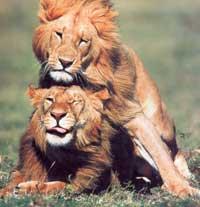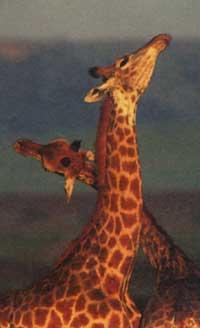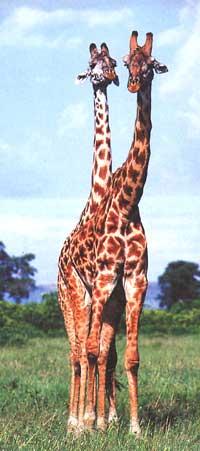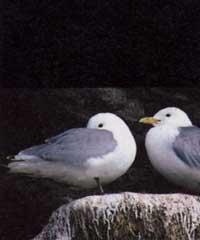Enveloped animals
When researcher Linda Wolfe published data on the subject, she was asked if she had "some hidden reason." He was also told to exchange photos and correct the data.

In the mid-1970s Wolfe worked in Japan investigating macaques. She soon discovered that females had sex with each other. And not only periodically. Females formed couples for periods, days, or weeks. During intermittent sexual intercourse, a lot of time was spent decorating one another. In these relationships, normally both couples reached orgasm. He believes it was a homosexual behavior, but most of the researchers appeared skeptical. The females did not know what they were doing. There are still researchers who have difficulty recognizing that peer relationships are "normal", that is, they are part of all the sexuality of primates.
We speak of Primate, but after analyzing the bibliography we have been able to observe in 470 species the relationships between the members of the same sex apparently related to sex. Most are mammals or birds, perhaps due to the greater propensity to study these groups of animals. When they published the data in a book (Biological Exuberance: Animal Homosexuality and Natural Diversity; Bruce Bagemihl 1999). Some considered the publication of this data as a milestone in scientific literature. Others, however, especially criticized the chapter that questioned Darwin's theory of evolution.

In any case, it has been clear that in animals the relationships between individuals of the same sex are quite normal (to push the chitazo between two "lesbian" gulls, "homosexual orgies" between manatees...). Sometimes homosexual behaviors appear associated with heterosexual bark, but other times homosexual relationships arise from emptiness: ostrich dance or the hidden game that only the females of rhesus makak play. About a quarter of the book's cases, the author observes signs of "affective" behaviors. There is no direct genital contact, but there is a "clear sexual or erotic connotation". For example, male lions "rub the head" and rotate together, or vampire males have erections when they stick and roll. The whale and dolphins rub the body and caress with fins and tails. Male giraffes spend a lot of time rubbing the neck, many times they are covered and have a clear orgasm. Atypical sexual behaviors and oral sex can also be observed: the triku or kirikiño females suck the genital organs and the orangutarras felizan.
In short, practically all of the sexual activity of homosexual persons can be equated in animals. That is, homosexuality is as "natural" as heterosexuality.
Social function or pleasure?
Although homosexuality seems so common, people are not very well known, not even biologists. Although the homosexual behavior of primates was first published at least 75 years ago, it is not even mentioned in basic books on primatology.

Scientists have ignored many times or simply have not considered homosexual behavior. Valerius Geist, for example, who for a long time has been investigating goats in the Rocky Mountains of the United States, recalls that 20 years ago D the ram S saw cover again and again the ram S. He dedicated two years to making believe that this behavior was basically a behavior of aggressive dominance. He never thought about the publication and today rejoices. In the end, he calls everything by name and accepts that the rams live in a homosexual society.
According to several researchers, "real" homosexuality (in centered definition, conceived as an anal intrusion by people who are not interested in females) hardly occurs in wild animals. They say that animals that cover the same sex are showing an aggressive attitude or practicing heterosexual relationships. Or they are declaring they are in jealousy, or their heterosexual partners are provoking jealousy.
But the fact that these sexual behaviors are a social function does not prevent the existence of a sexual function as well. According to Wolfe, the behavior of the macechites has a social function, but also a goal of sexual pleasure. Furthermore, he believes that the main goal is to achieve sexual pleasure. Several primatologists try to deny that homosexual behavior is related to pleasure. But there is a species that seems that pleasure and homosexuality are intimately related: the bonobo or the pygmy chimpanzee. Forget about the human being. If homosexual behavior is normal, it is in groups of bonobos. At least striking: anyone has sex with anyone, no matter the sex or age of the other.
The females are placed in the most suitable position to touch the sexual organs and the males give big kisses to stimulate with the tongue. The reason for this obvious behavior is the strengthening of ties. One of the characteristics of sexual relationships is relaxation, which seems to relieve tensions and unite the group. But, why do bonobos need more calm after intercourse than primates? Note that bonobos groups are larger than those of other primates, with 20 or more units, and that chimpanzees are of the order of 5-10. This can be the reason: the need to relax with a larger group. Bonobos use caresses, kisses and sex. And it seems to be suitable for that goal, since bonoboes are usually more peaceful groups than chimpanzees.

Those who see homosexuality in the relationships between animals of the same sex consider that when analyzing the behavior of animals, little attention is paid to sex, and therefore, in general, the data on the homosexuality of animals are so scarce.
To complicate things a little, in addition, in some species it is very difficult to distinguish sex. The staff of the Edinburgh Zoo put the names to the Kings penguins based on sexual behavior, but some had to change their names. Those who were initially Eric and Dora (supposedly male and female) became Erica and Dora (both females). Bertha and Caroline, however, got rid of the "complaint" to be lesbians after confirming their gay status, becoming Bertrand and Charles.
Returning to the Japanese macaques, despite trying to find the reason for their behavior, nothing clear has been found. It does not seem that females use sex to fix the hierarchy. They create ties, but they behave as if they had never had contact when the relationship is over. Also in single-male groups males do not have much work and females, often, have more interest in the other females. His behavior is bisexual.
Natural behavior

The main reason why human homosexuality is denied is based on the unnatural, and is working to clarify whether it is homosexual or natural. If it carries in the genes, if it has the longest fingers, if it is left. It seems that having some mark or sign, that is, being genetic, reassures people; in short, if those misfortunes were born like this, what are we going to do to them?
However, when reading these types of articles it is clear that at least it is not unnatural, perhaps it is not very common, but natural. Therefore, in nature there is a behavior similar to this “special”. We can sleep peacefully! However, whether or not genetic, is it so difficult for us to consider normal behavior? It may not be very normal, but natural, then.
Published in the supplement Natura de Gara
Buletina
Bidali zure helbide elektronikoa eta jaso asteroko buletina zure sarrera-ontzian











